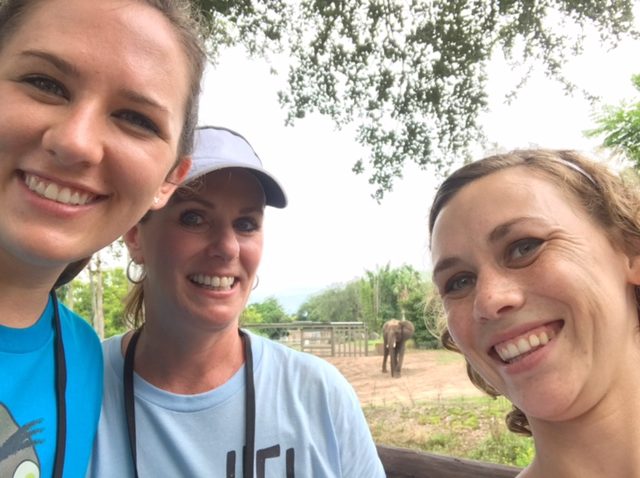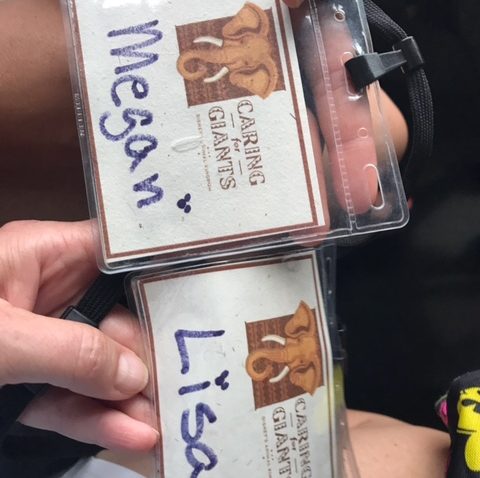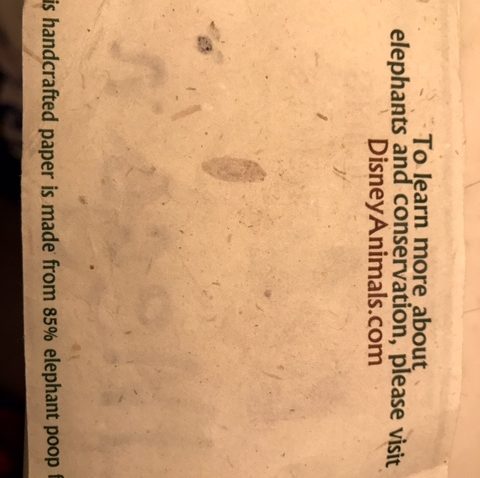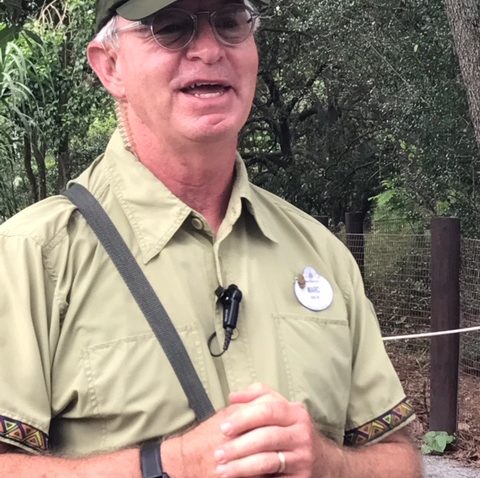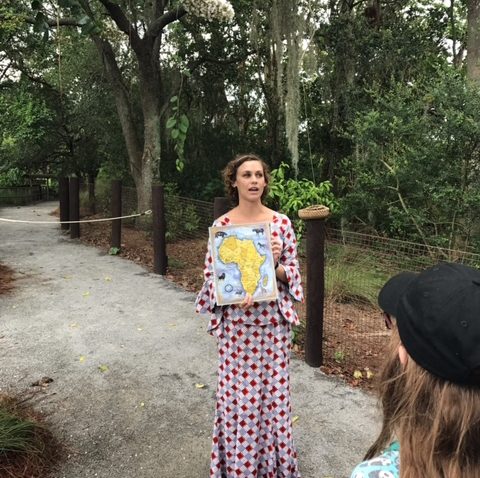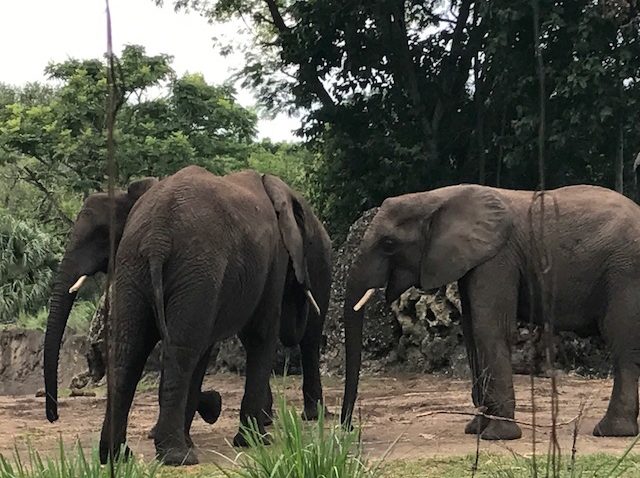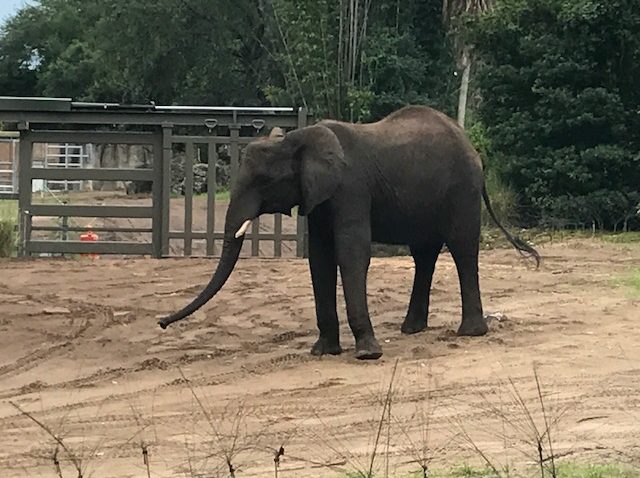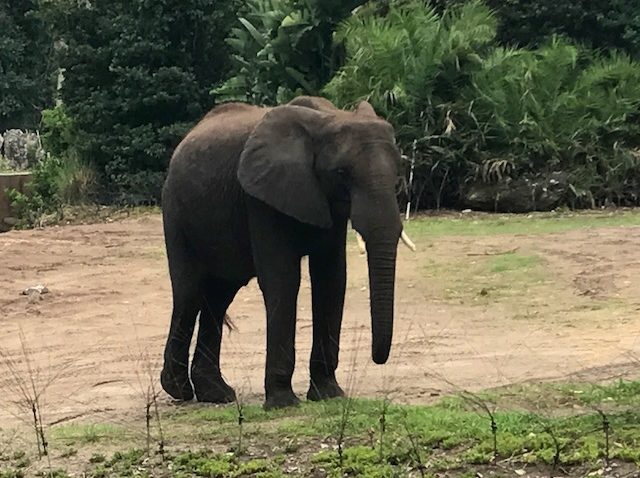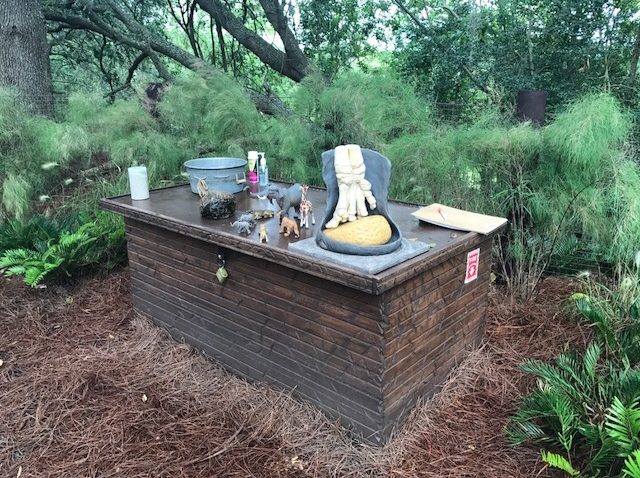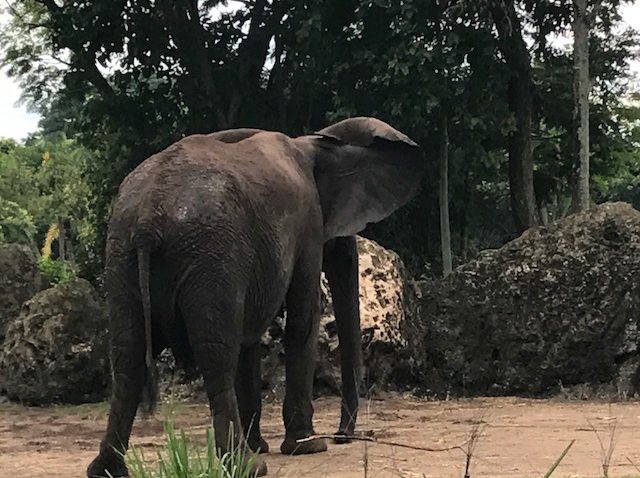Recently we crossed a long-awaited item off our Disney wish list. Raymond, Joseph and I finally, after talking about it for years, took the Wild Africa Trek in Animal Kingdom. Was it everything we hoped it would be? Yes and no. Much of the experience was the way we’d imagined and we learned a lot about the animals we saw along the way. To be fair and balanced, I must also add that some of this pricey adventure was disappointing. Here are the details of our experience on…
Animal Kingdom’s Wild Africa Trek
We were booked for the day after Christmas, but the only person who knew it was me. During Christmas dinner at the California Grill, I sprang the surprise and then everyone was excited about the next day’s big plan. After breakfast at Tusker House, we’d have time to go on Kilimanjaro Safari before we checked in for the Wild Africa Trek near the Safari’s entrance. We were scheduled for the 10:15 am trek, which would end at 1:15 pm. Information we received about the trek ahead of time emphasized the need to dress in pants or shorts with sturdy, closed-toe shoes. We all wore jeans, t-shirts and athletic shoes, which were perfect choices.
As soon as we arrived, the Cast Members got busy outfitting us in our gear. We were weighed (very discreetly) and strapped into a harness/vest combo. We then had all our loose items strapped on (Disney provided straps for glasses and cell phones/cameras) and received our complimentary water bottles to fill and also have secured to our vests. (Note: the harness were snug around the tops of our legs, so loose pants tended to bunch up on some folks. Looked uncomfortable!) We were also given wireless audio devices that allowed us to easily hear our guides throughout the first part of the tour. After some instruction and a group photo, we were ready to go. Photos are included in the price of this experience and the guides take pictures all along the way from start to finish. (I’m not using any of those photos here due language in the licensing agreement that comes with the pictures.)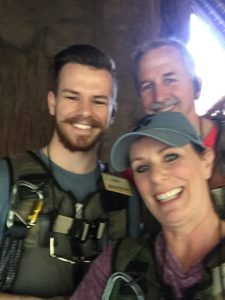
So far, so good. Our group of twelve guests was made up of Raymond, Joseph and I, two adult men (father and son maybe), a mom with young son and daughter (minimum age for the trek is 8), and a family of four (with teen girl and tween boy). We noticed early on that the tone of the tour was geared strongly towards children. There were some cute jokes involving Frozen references, but also some not-so-cute childishness that I thought even the kids didn’t seem to like. We were taught to use Swahili words like hakuna matata (no worries), asante sana (thank you very much), twende (let’s go) and kwaherini (farewell). The guides insisted that every time they asked if we were ready to go, we throw our hands on the air and say twende! But when the group was enthusiastic, we received a lecture about how we had to be quiet because we would upset the animals. Personally, I thought we could have done without both having to say twende repeatedly and the lecture.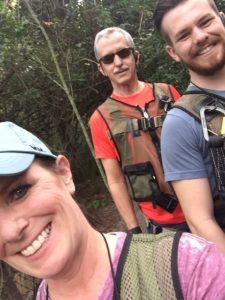
The tour was broken up into three main parts: The walking path and rope bridges, touring by safari truck, and eating on the savanna.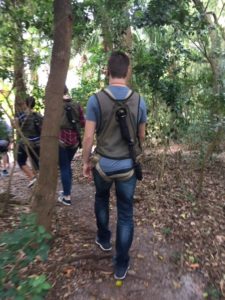
Walking path and rope bridges: Here we learned about hippos and crocodiles. The path to the hippo pool was a little rugged and jungle-esque, and that part was fun. There was an additional guide waiting to tell us about hippos. She had some hippo snacks in a big plastic bowl and she struck the bowl repeatedly with a plastic stick to lure the two male hippos (father and son) over for a snack, so we could have a closer look at these enormous and interesting animals. 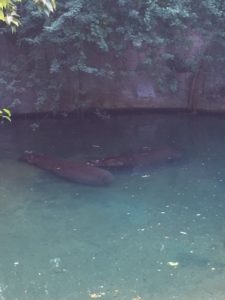 Unfortunately, the hippos were having none of it. They remained completely uninterested in the guide’s tasty offering. They did not budge an inch. After that, we got to look at a reproduction hippo skull before we threw our hands in the air and quietly said twende.
Unfortunately, the hippos were having none of it. They remained completely uninterested in the guide’s tasty offering. They did not budge an inch. After that, we got to look at a reproduction hippo skull before we threw our hands in the air and quietly said twende.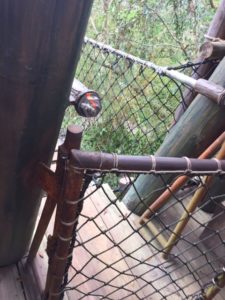
Next we made our way to the rope bridges. There’s a lot of concern for safety, which is understandable of course, but it’s also time-consuming. Before we can be clipped to any of the safety cables, each person’s harness must be checked and tightened as necessary. When my harness was checked, the guide loudly proclaimed, “This is way too loose!” before proceeding to tighten the straps. This bugged me and I and wanted to reply, “YOU are the one who strapped this thing on me in the first place!”, but I managed to restrain myself. This particular guide was snarky and condescending throughout the tour and as time went on, it irritated me more and more. Especially when he wasted time being especially unpleasant to the youngest member of the group. Poor kid was just excited and didn’t deserve the extra-snarky treatment.
There were a lot of small details involved when walking over the rope bridges – stand in a certain spot when it’s your turn, hook your cable to a pulley which a cast member up on a platform uses to get your harness attached above the bridge. Wait until told, open the gate to the bridge (watch your feet), step onto the bridge, close the gate. One at a time, we made our way over the bridge – the next person was allowed to go only when the person in front of them had reached the half-way point. Kids went with an adult before and after them. The bridges are made to seem rickety and well-worn. Many of the slats are “broken”, so we had to pay careful attention to where we were stepping and the going was slow. This took up a big chunk of touring time. If you are afraid of heights, you will not like this part. If you’re a thrill junky who’s zip-lined before, this will most likely seem very mild. You do get to see hippos and many enormous crocodiles below and a guide will take your picture on the bridges.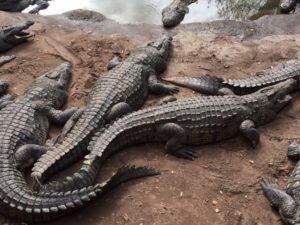
After the bridges and another safety check, our harnesses were clipped onto an overlook for more crocodile viewing. We were cautioned many times to be sure we didn’t lean out in a way that would put any pressure on our harnesses. We learned some interesting facts about crocodiles and got to ask some questions before our group moved on to board our safari truck. We were, thankfully, able to ditch the harness/vests at this time.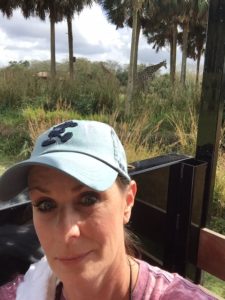
As a huge fan of Kilimanjaro Safaris, this was probably my favorite part of the tour. We traveled the same path as the Safaris (for the most part), but got to stop several times to learn more about giraffes, African painted dogs, and a few other animals and take pictures. While the vehicle was parked, we could stand up and move around (in the truck bed) for better animal viewing and picture-taking. We were given some ice-cold, individually wrapped, bug-repellant-treated wash cloths.
Our safari truck eventually made its way to a building where we had lunch. We each received a metal container full of smaller containers, naan bread, and an edible flower.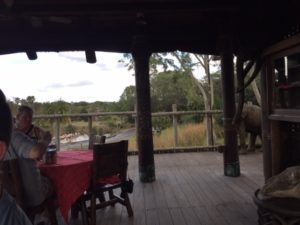
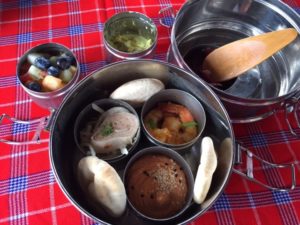
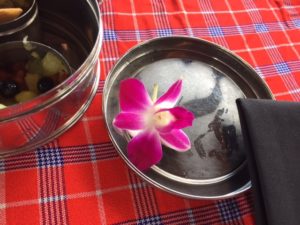 The food was great! Humus, chicken salad, cured meats, a shrimp, a slice of salmon roll-up, and fruit. Juice was available as well. After we ate, we could move to the far side of the building where the deck overlooked some rhinos. I mentioned to our guide that we’d taken the safari that morning and I had a question about something we’d seen. He actually rolled his eyes at me and asked, “Why would you take the safari if you were coming on the Wild Africa Trek?” I love the safari and it’s a must-do on every visit to Animal Kingdom. I had FastPasses booked later in the afternoon for other attractions, but the safari is best (to us) in the early morning. Did I explain all that? Nope. I just said we wanted to scope out where we’d be going on the tour if we could. Then I asked my question about the rhinos.
The food was great! Humus, chicken salad, cured meats, a shrimp, a slice of salmon roll-up, and fruit. Juice was available as well. After we ate, we could move to the far side of the building where the deck overlooked some rhinos. I mentioned to our guide that we’d taken the safari that morning and I had a question about something we’d seen. He actually rolled his eyes at me and asked, “Why would you take the safari if you were coming on the Wild Africa Trek?” I love the safari and it’s a must-do on every visit to Animal Kingdom. I had FastPasses booked later in the afternoon for other attractions, but the safari is best (to us) in the early morning. Did I explain all that? Nope. I just said we wanted to scope out where we’d be going on the tour if we could. Then I asked my question about the rhinos.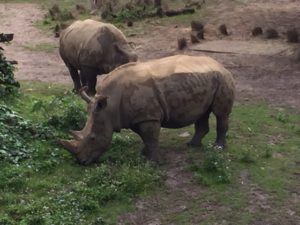
On that morning’s Kilimanjaro Safari, we’d noticed one rhino facing off against three other rhinos. They were all very close together with the one nose-to-nose with the other three who stood shoulder-to-shoulder in a stare down. The guide explained that a male rhino was being allowed to spend small periods of time in the enclosure with the three female rhinos, but the three were firmly against getting to know the poor lonely guy any better and tended to band together to indicate a hard pass on his advances. This was exactly the kind of information we’d hoped to learn on this adventure – to find out more about individual animals at Animal Kingdom…who they are, if you will, and what their lives are like living in the park. When time was up for eating and rhino-viewing, we got back on the truck and continued on our way to the end of the tour. We exited the truck at the same place as Kilimanjaro Safari and made our way to the lockers to retrieve our stuff. The guides passed out slips of paper that provided directions on how to get our pictures from the tour.
When time was up for eating and rhino-viewing, we got back on the truck and continued on our way to the end of the tour. We exited the truck at the same place as Kilimanjaro Safari and made our way to the lockers to retrieve our stuff. The guides passed out slips of paper that provided directions on how to get our pictures from the tour.
Would we do it again? Not for the price we paid (during peak season, $249 per person). We think a kid-free option like Disney Cruise Line offers for many of their excursions would be appealing. Not that the kids were trouble, they were very well-behaved and enjoyable. We just felt like the guides’ scripts were targeted towards children, people who know nothing about animals, and Animal Kingdom park newbies. As long-time Animal Kingdom fans who have visited many times, we wanted more in-depth information with a less condescending delivery. I know several people who have taken the Wild Africa Trek and all had a wonderful experience. I’m sure it greatly depends on the guides and unfortunately, one of ours seemed to not like his job very much.
Have you taken the Wild Africa Trek? How was your experience?
Like this:
Like Loading...
